oil temperature MERCEDES-BENZ C-CLASS SALOON 2014 Owners Manual
[x] Cancel search | Manufacturer: MERCEDES-BENZ, Model Year: 2014, Model line: C-CLASS SALOON, Model: MERCEDES-BENZ C-CLASS SALOON 2014Pages: 489, PDF Size: 14.88 MB
Page 7 of 489
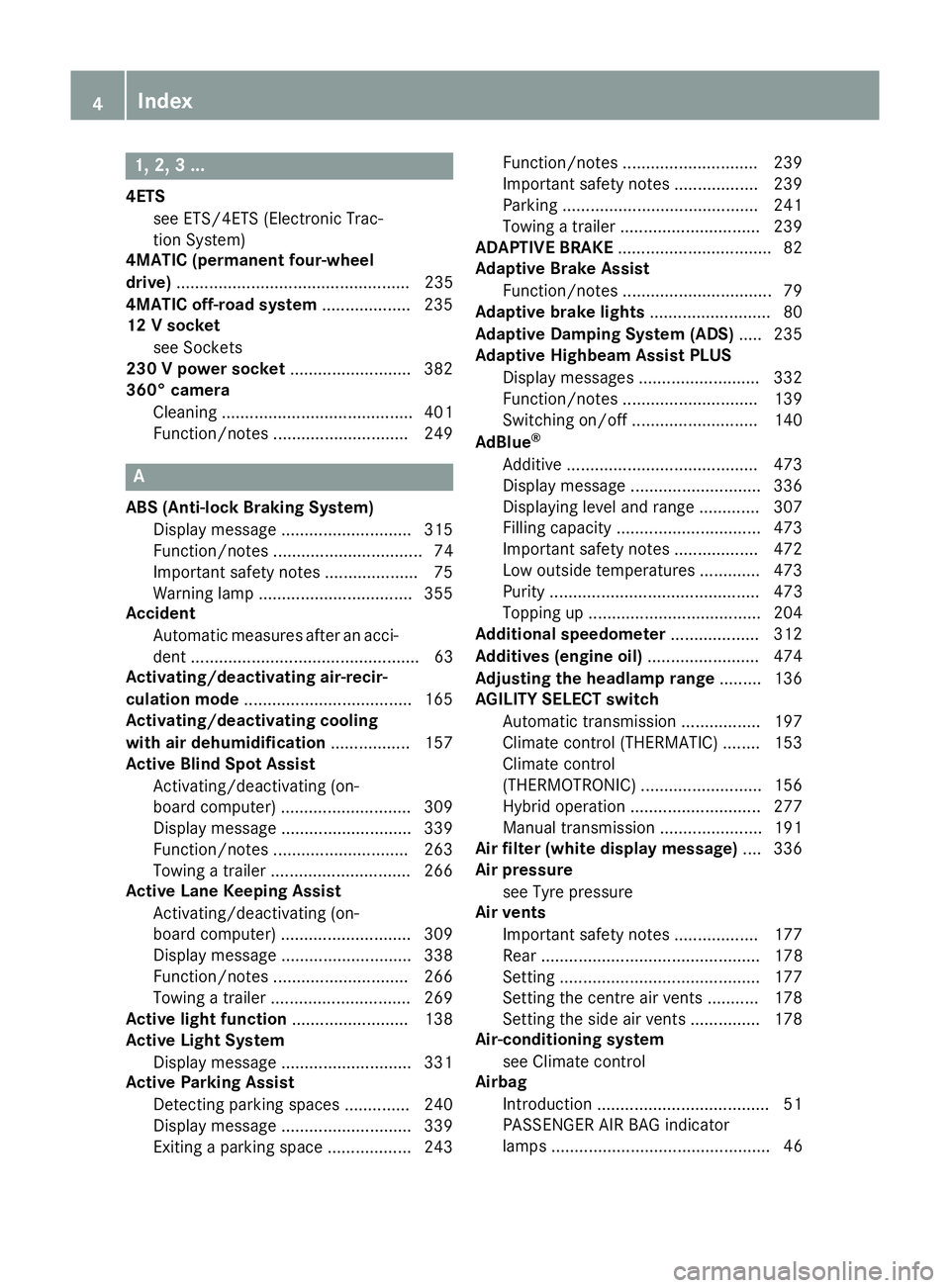
1, 2, 3 ...
4ETS see ETS/4ETS (Electronic Trac-
tion System)
4MATIC (permanent four-wheel
drive) .................................................. 235
4MATIC off-road system ...................235
12 V socket
see Sockets
230 V power socket .......................... 382
360° camera
Cleaning ......................................... 401
Function/notes ............................ .249 A
ABS (Anti-lock Braking System) Display message ............................ 315
Function/notes ................................ 74
Important safety notes .................... 75
Warning lamp ................................. 355
Accident
Automatic measures after an acci-
dent ................................................. 63
Activating/deactivating air-recir-
culation mode ................................... .165
Activating/deactivating cooling
with air dehumidification ................. 157
Active Blind Spot Assist
Activating/deactivating (on-
board computer) ............................ 309
Display message ............................ 339
Function/notes ............................ .263
Towing a trailer .............................. 266
Active Lane Keeping Assist
Activating/deactivating (on-
board computer) ............................ 309
Display message ............................ 338
Function/notes ............................ .266
Towing a trailer .............................. 269
Active light function ......................... 138
Active Light System
Display message ............................ 331
Active Parking Assist
Detecting parking spaces .............. 240
Display message ............................ 339
Exiting a parking space .................. 243 Function/notes ............................
.239
Important safety notes .................. 239
Parking .......................................... 241
Towing a trailer .............................. 239
ADAPTIVE BRAKE ................................. 82
Adaptive Brake Assist
Function/notes ................................ 79
Adaptive brake lights .......................... 80
Adaptive Damping System (ADS) ..... 235
Adaptive Highbeam Assist PLUS
Display messages .......................... 332
Function/notes ............................ .139
Switching on/off ........................... 140
AdBlue ®
Additive ......................................... 473
Display message ............................ 336
Displaying level and range ............. 307
Filling capacity ............................... 473
Important safety notes .................. 472
Low outside temperatures ............. 473
Purity ............................................. 473
Topping up ..................................... 204
Additional speedometer ................... 312
Additives (engine oil) ........................ 474
Adjusting the headlamp range ......... 136
AGILITY SELECT switch
Automatic transmission ................. 197
Climate control (THERMATIC) ....... .153
Climate control
(THERMOTRONIC) .......................... 156
Hybrid operatio n ............................ 277
Manual transmission ..................... .191
Air filter (white display message) .... 336
Air pressure
see Tyre pressure
Air vents
Important safety notes .................. 177
Rear ............................................... 178
Setting .......................................... .177
Setting the centre air vents ........... 178
Setting the side air vents .............. .178
Air-conditioning system
see Climate control
Airbag
Introduction ..................................... 51
PASSENGER AIR BAG indicator
lamps ............................................... 46 4
Index
Page 19 of 489

Notes/placing in the bracket .........3
86
Transmission output (maximum) .... 466
Modifying the programming (key) ..... 92
MOExtended tyres .............................408
Motorway mode ................................ 138
MP3
Operating ....................................... 303
Multifunction display
Function/notes ............................ .295
Permanent display ......................... 312
Multifunction steering wheel
Operating the on-board computer .. 294
Overview .......................................... 36 N
Navigation Menu (on-board computer) ............ 300
Notes on running in a new vehicle .. 180O
Occupant safety Automatic measures after an acci-
dent ................................................. 63
Children in the vehicle ..................... 63
Important safety notes .................... 45
Pets in the vehicle ........................... 74
PRE-SAFE ®
(anticipatory occu-
pant protection) ............................... 62
Seat belts ........................................ 47
Odometer .......................................... .298
Oil
see Engine oil
On-board computer
Assistance graphic menu .............. .306
Assistance menu ........................... 307
Display messages .......................... 314
Displaying a service message ....... .395
DISTRONIC PLUS ........................... 228
Factory settings ............................ .313
Head-up displa y............................. 295
Important safety notes .................. 292
Instrument cluster menu ............... 312
Light menu ..................................... 311
Media menu ................................... 302
Menu overview .............................. 297
Message memory .......................... 314 Navigation menu ............................ 300
Operating the TV ............................ 304
Operating video DVD ..................... 303
Operation ....................................... 294
Radio menu ................................... 302
Service menu ................................. 306
Settings menu ............................... 307
Standard display ............................ 298
Telephone menu ............................ 304
Trip menu ...................................... 298
Vehicle menu ................................. 313
Opening and closing the side trim
panels ................................................. 144
Operating instructions
Vehicle equipment ........................... 25
Operating mode
Overrun mode ................................ 279
Stationary vehicle .......................... 278
Operating safety
Declaration of conformity ................ 27
Important safety note ...................... 25
Operating system
see On-board computer
Outside temperature display ........... 293
Overhead control panel ...................... 39
Override feature
Rear side window s........................... 73
Overrun mode .................................... 280
Overrun mode, extended .................. 280
Owner's Manual
Overview .......................................... 25 P
Paint code .......................................... 468
Paintwork (cleaning instructions) ... 398
Panic alarm .......................................... 44
Panorama sliding sunroof
Important safety information ......... 110
Opening/closing ............................ 112
Problem (malfunction) ................... 115
Rain closing feature ....................... 113
Resetting ....................................... 114
Parking
Hybrid vehicles .............................. 281
Important safety notes .................. 207
Parking brake ................................ 209 16
Index
Page 395 of 489
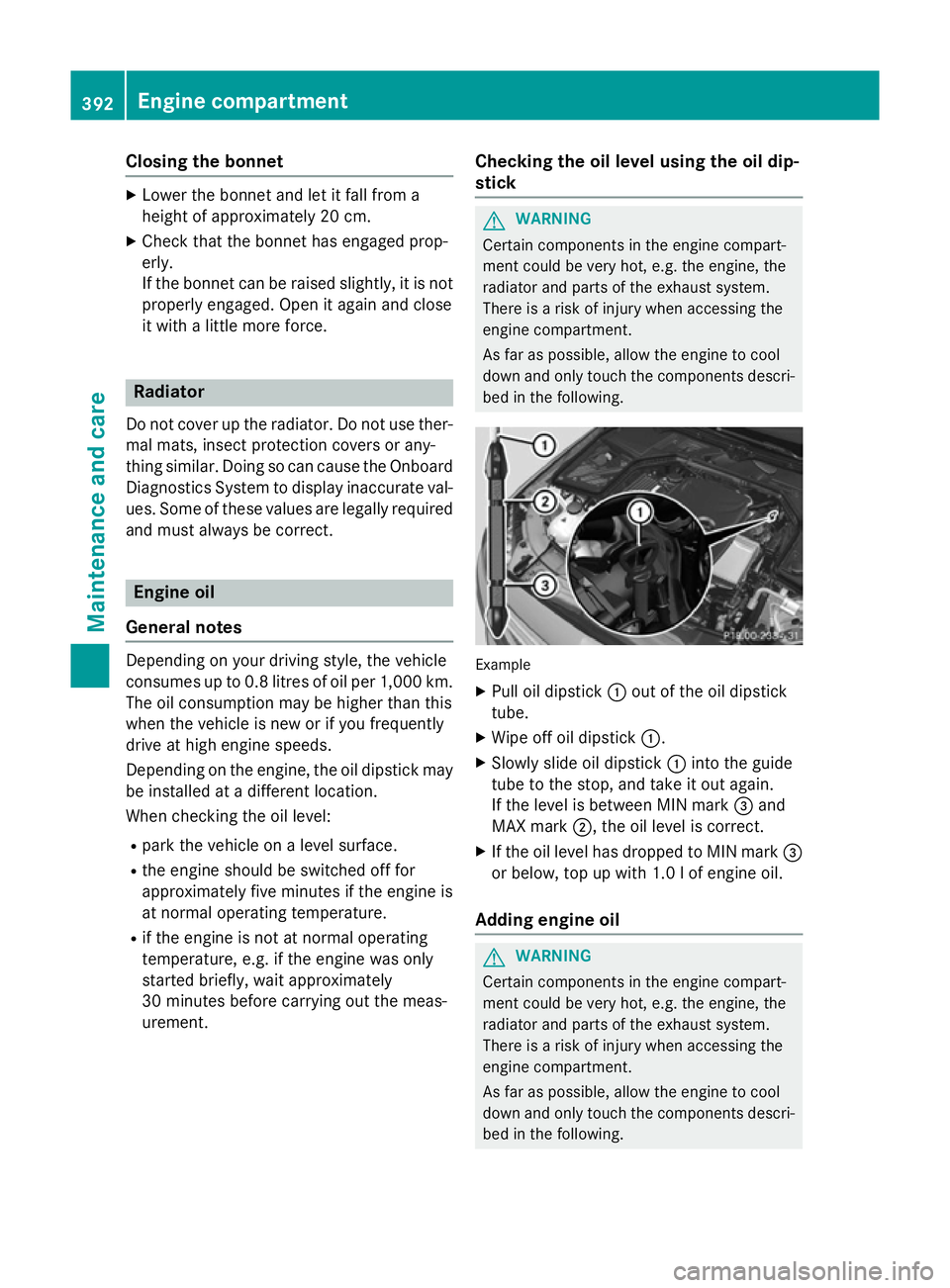
Closing the bonnet
X
Lower the bonnet and let it fall from a
height of approximately 20 cm.
X Check that the bonnet has engaged prop-
erly.
If the bonnet can be raised slightly, it is not
properly engaged. Open it again and close
it with a little more force. Radiator
Do not cover up the radiator. Do not use ther-
mal mats, insect protection covers or any-
thing similar. Doing so can cause the Onboard Diagnostics System to display inaccurate val-
ues. Some of these values are legally required
and must always be correct. Engine oil
General notes Depending on your driving style, the vehicle
consumes up to 0.8 litres of oil per 1,000 km.
The oil consumption may be higher than this
when the vehicle is new or if you frequently
drive at high engine speeds.
Depending on the engine, the oil dipstick may be installed at a different location.
When checking the oil level:
R park the vehicle on a level surface.
R the engine should be switched off for
approximately five minutes if the engine is
at normal operating temperature.
R if the engine is not at normal operating
temperature, e.g. if the engine was only
started briefly, wait approximately
30 minutes before carrying out the meas-
urement. Checking the oil level using the oil dip-
stick G
WARNING
Certain components in the engine compart-
ment could be very hot, e.g. the engine, the
radiator and parts of the exhaust system.
There is a risk of injury when accessing the
engine compartment.
As far as possible, allow the engine to cool
down and only touch the components descri- bed in the following. Example
X Pull oil dipstick :out of the oil dipstick
tube.
X Wipe off oil dipstick :.
X Slowly slide oil dipstick :into the guide
tube to the stop, and take it out again.
If the level is between MIN mark =and
MAX mark ;, the oil level is correct.
X If the oil level has dropped to MIN mark =
or below, top up with 1.0 l of engine oil.
Adding engine oil G
WARNING
Certain components in the engine compart-
ment could be very hot, e.g. the engine, the
radiator and parts of the exhaust system.
There is a risk of injury when accessing the
engine compartment.
As far as possible, allow the engine to cool
down and only touch the components descri- bed in the following. 392
Engine compartmentMaintenance and care
Page 475 of 489
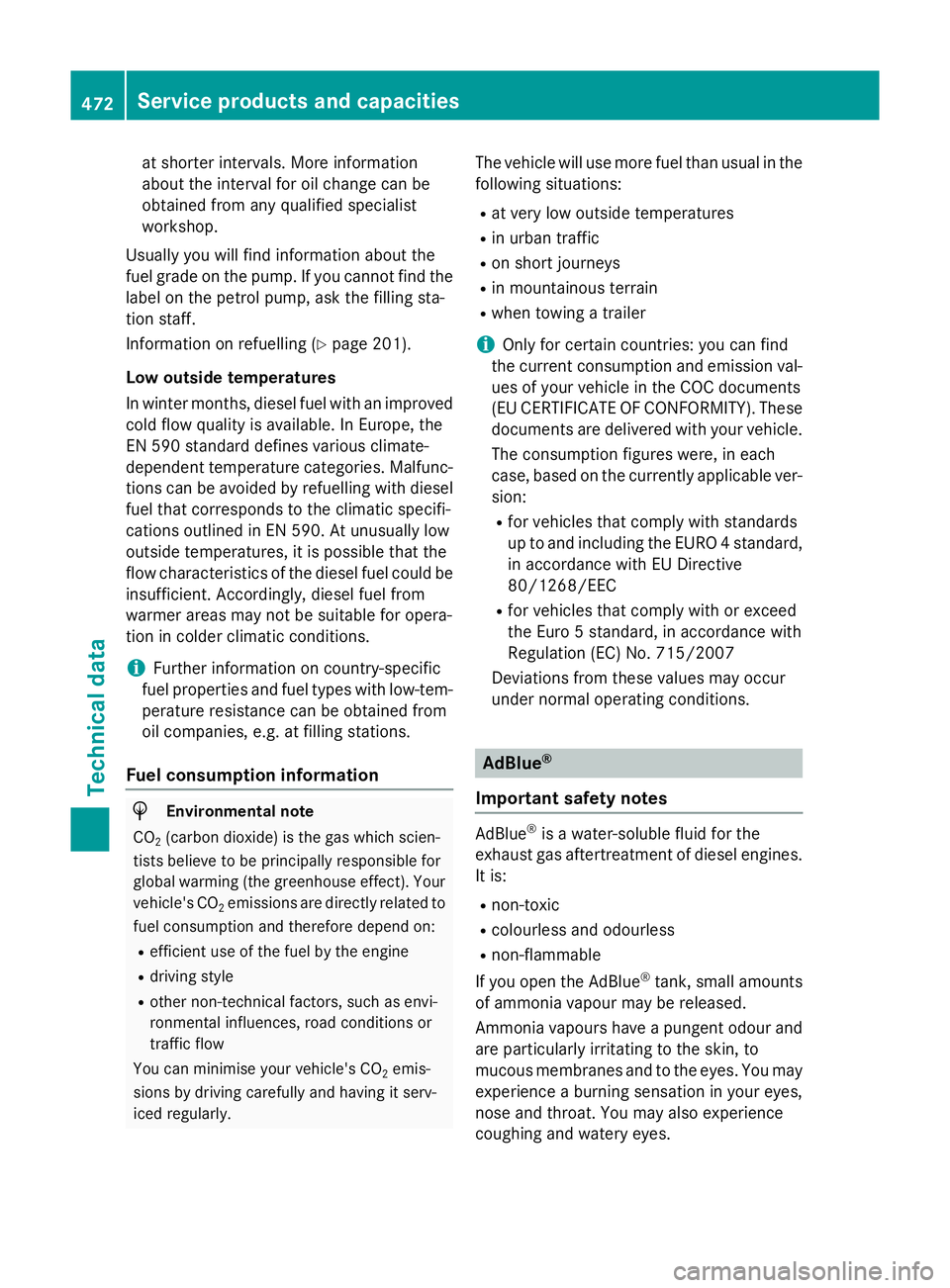
at shorter intervals. More information
about the interval for oil change can be
obtained from any qualified specialist
workshop.
Usually you will find information about the
fuel grade on the pump. If you cannot find the label on the petrol pump, ask the filling sta-
tion staff.
Information on refuelling (Y page 201).
Low outside temperatures
In winter months, diesel fuel with an improved cold flow quality is available. In Europe, the
EN 590 standard defines various climate-
dependent temperature categories. Malfunc-
tions can be avoided by refuelling with diesel
fuel that corresponds to the climatic specifi-
cations outlined in EN 590. At unusually low
outside temperatures, it is possible that the
flow characteristics of the diesel fuel could be insufficient. Accordingly, diesel fuel from
warmer areas may not be suitable for opera-
tion in colder climatic conditions.
i Further information on country-specific
fuel properties and fuel types with low-tem-
perature resistance can be obtained from
oil companies, e.g. at filling stations.
Fuel consumption information H
Environmental note
CO 2(carbon dioxide) is the gas which scien-
tists believe to be principally responsible for
global warming (the greenhouse effect). Your
vehicle's CO 2emissions are directly related to
fuel consumption and therefore depend on:
R efficient use of the fuel by the engine
R driving style
R other non-technical factors, such as envi-
ronmental influences, road conditions or
traffic flow
You can minimise your vehicle's CO 2emis-
sions by driving carefully and having it serv-
iced regularly. The vehicle will use more fuel than usual in the
following situations:
R at very low outside temperatures
R in urban traffic
R on short journeys
R in mountainous terrain
R when towing a trailer
i Only for certain countries: you can find
the current consumption and emission val-
ues of your vehicle in the COC documents
(EU CERTIFICATE OF CONFORMITY). These documents are delivered with your vehicle.
The consumption figures were, in each
case, based on the currently applicable ver-sion:
R for vehicles that comply with standards
up to and including the EURO 4 standard, in accordance with EU Directive
80/1268/EEC
R for vehicles that comply with or exceed
the Euro 5 standard, in accordance with
Regulation (EC) No. 715/2007
Deviations from these values may occur
under normal operating conditions. AdBlue
®
Important safety notes AdBlue
®
is a water-soluble fluid for the
exhaust gas aftertreatment of diesel engines. It is:
R non-toxic
R colourless and odourless
R non-flammable
If you open the AdBlue ®
tank, small amounts
of ammonia vapour may be released.
Ammonia vapours have a pungent odour and
are particularly irritating to the skin, to
mucous membranes and to the eyes. You may experience a burning sensation in your eyes,
nose and throat. You may also experience
coughing and watery eyes. 472
Service products and capacitiesTechnical data
Page 476 of 489
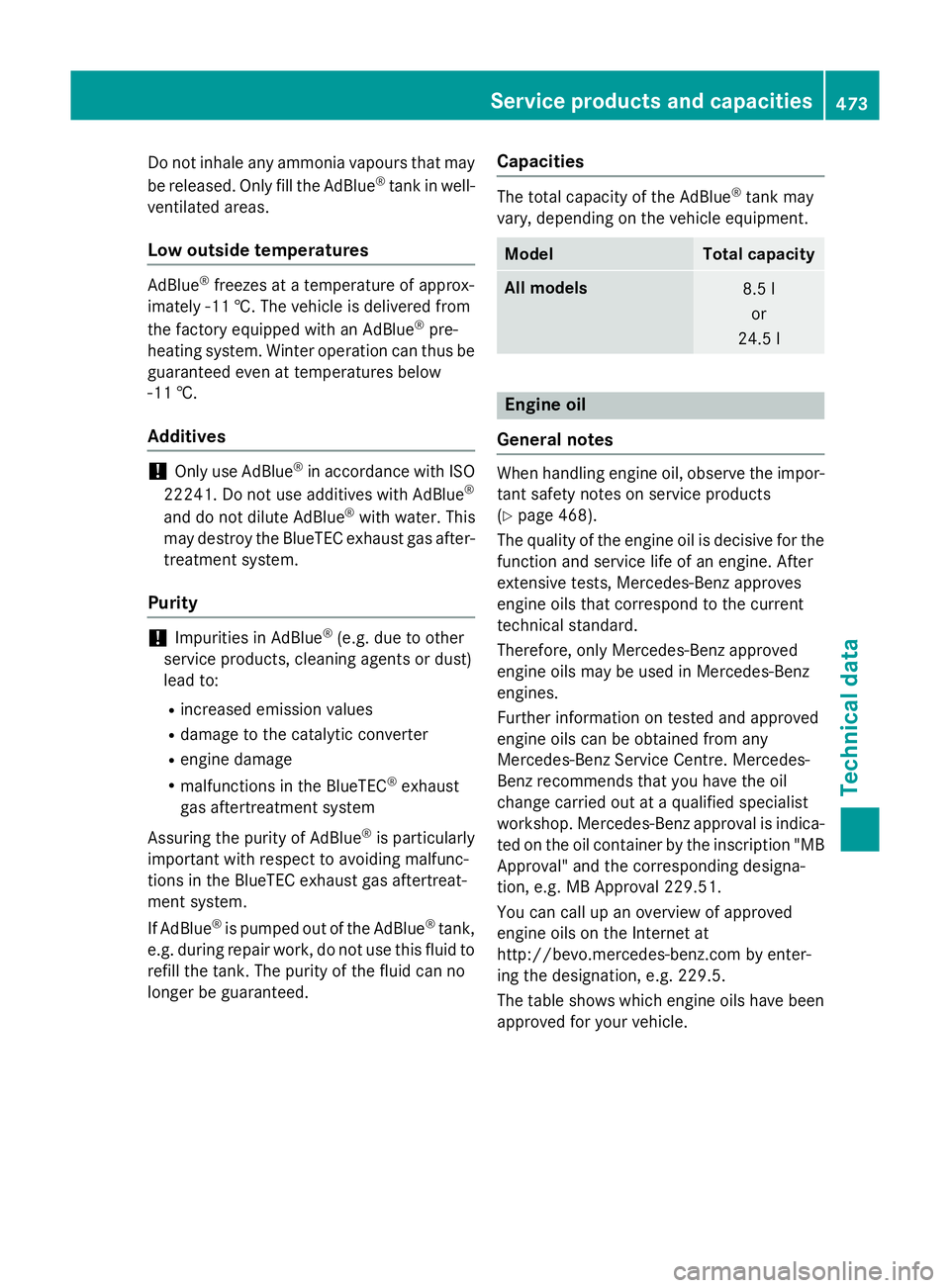
Do not inhale any ammonia vapours that may
be released. Only fill the AdBlue ®
tank in well-
ventilated areas.
Low outside temperatures AdBlue
®
freezes at a temperature of approx-
imately -11 †. The vehicle is delivered from
the factory equipped with an AdBlue ®
pre-
heating system. Winter operation can thus be guaranteed even at temperatures below
-11 †.
Additives !
Only use AdBlue ®
in accordance with ISO
22241. Do not use additives with AdBlue ®
and do not dilute AdBlue ®
with water. This
may destroy the BlueTEC exhaust gas after- treatment system.
Purity !
Impurities in AdBlue ®
(e.g. due to other
service products, cleaning agents or dust)
lead to:
R increased emission values
R damage to the catalytic converter
R engine damage
R malfunctions in the BlueTEC ®
exhaust
gas aftertreatment system
Assuring the purity of AdBlue ®
is particularly
important with respect to avoiding malfunc-
tions in the BlueTEC exhaust gas aftertreat-
ment system.
If AdBlue ®
is pumped out of the AdBlue ®
tank,
e.g. during repair work, do not use this fluid to refill the tank. The purity of the fluid can no
longer be guaranteed. Capacities The total capacity of the AdBlue
®
tank may
vary, depending on the vehicle equipment. Model Total capacity
All models
8.5 l
or
24.5 l Engine oil
General notes When handling engine oil, observe the impor-
tant safety notes on service products
(Y page 468).
The quality of the engine oil is decisive for the function and service life of an engine. After
extensive tests, Mercedes-Benz approves
engine oils that correspond to the current
technical standard.
Therefore, only Mercedes-Benz approved
engine oils may be used in Mercedes-Benz
engines.
Further information on tested and approved
engine oils can be obtained from any
Mercedes-Benz Service Centre. Mercedes-
Benz recommends that you have the oil
change carried out at a qualified specialist
workshop. Mercedes-Benz approval is indica-
ted on the oil container by the inscription "MB Approval" and the corresponding designa-
tion, e.g. MB Approval 229.51.
You can call up an overview of approved
engine oils on the Internet at
http://bevo.mercedes-benz.com by enter-
ing the designation, e.g. 229.5.
The table shows which engine oils have been
approved for your vehicle. Service products and capacities
473Technical data Z
Page 477 of 489
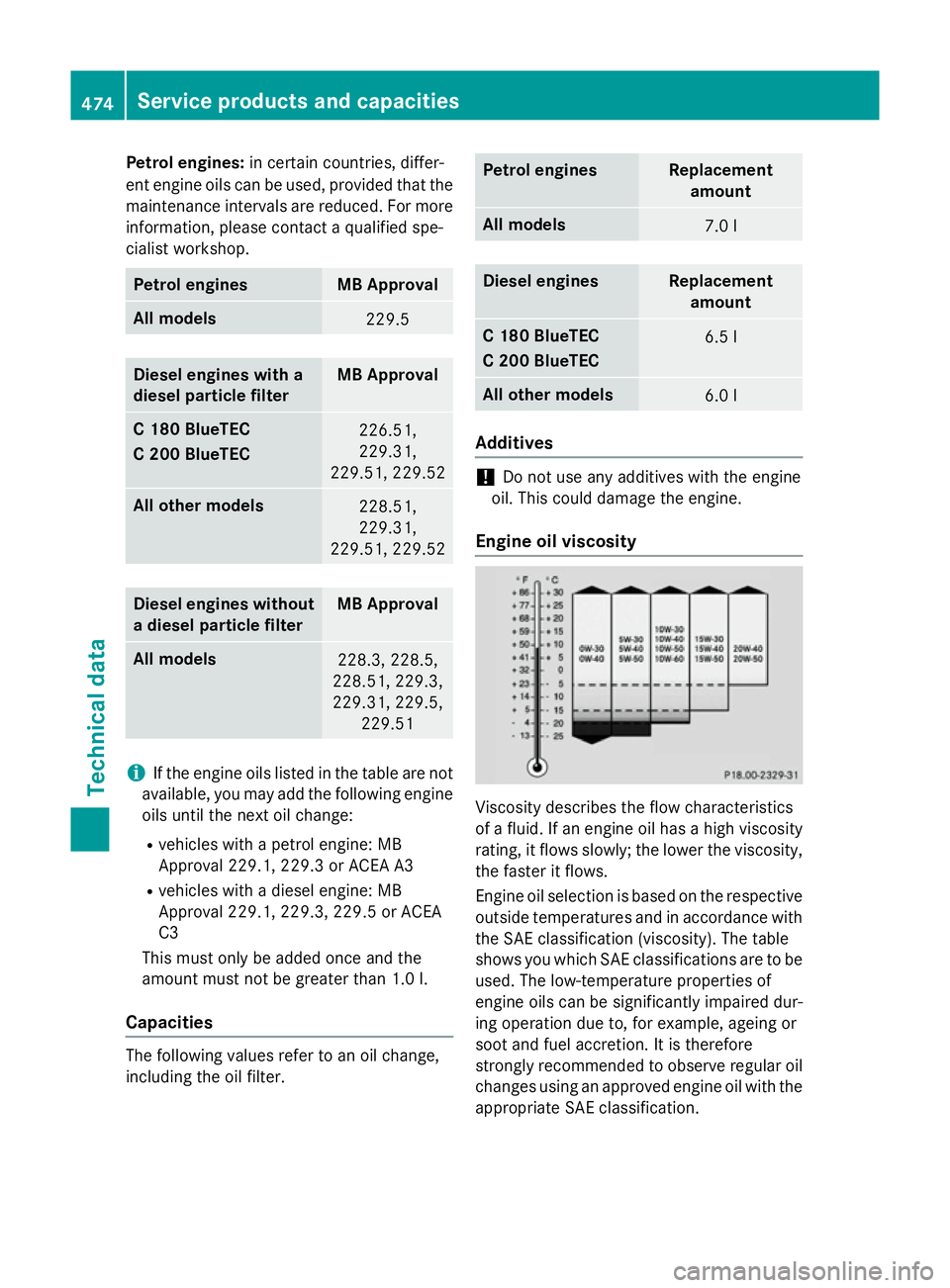
Petrol engines:
in certain countries, differ-
ent engine oils can be used, provided that the
maintenance intervals are reduced. For more
information, please contact a qualified spe-
cialist workshop. Petrol engines MB Approval
All models
229.5
Diesel engines with a
diesel particle filter MB Approval
C 180 BlueTEC
C 200 BlueTEC
226.51,
229.31,
229.51, 229.52 All other models
228.51,
229.31,
229.51, 229.52 Diesel engines without
a diesel particle filter MB Approval
All models
228.3, 228.5,
228.51, 229.3,
229.31, 229.5, 229.51 i
If the engine oils listed in the table are not
available, you may add the following engine
oils until the next oil change:
R vehicles with a petrol engine: MB
Approval 229.1, 229.3 or ACEA A3
R vehicles with a diesel engine: MB
Approval 229.1, 229.3, 229.5 or ACEA
C3
This must only be added once and the
amount must not be greater than 1.0 l.
Ca pacities The following values refer to an oil change,
including the oil filter. Petrol engines Replacement
amount All models
7.0 l
Diesel engines Replacement
amount C 180 BlueTEC
C 200 BlueTEC
6.5 l
All other models
6.0 l
Additives
!
Do not use any additives with the engine
oil. This could damage the engine.
Engine oil viscosity Viscosity describes the flow characteristics
of a fluid. If an engine oil has a high viscosity
rating, it flows slowly; the lower the viscosity,
the faster it flows.
Engine oil selection is based on the respective outside temperatures and in accordance with
the SAE classification (viscosity). The table
shows you which SAE classifications are to be
used. The low-temperature properties of
engine oils can be significantly impaired dur-
ing operation due to, for example, ageing or
soot and fuel accretion. It is therefore
strongly recommended to observe regular oil changes using an approved engine oil with the
appropriate SAE classification. 474
Service products and capacitiesTechnical data
Page 478 of 489

Brake fluid
G
WARNING
The brake fluid continuously absorbs mois-
ture from the air. This results in the boiling
point of the brake fluid lowering. If the boiling
point of the brake fluid is too low, vapour
pockets may form when the brakes are sub-
jected to a heavy load. This would impair brak- ing efficiency. There is a risk of an accident.
Have the brake fluid renewed at the prescri-
bed intervals.
When handling brake fluid, observe the
important safety notes on service products
(Y page 468).
The brake fluid change intervals can be found in the Service Booklet.
Only use brake fluid approved by Mercedes-
Benz according to MB Approval 331.0.
Information about approved brake fluid can
be obtained at any qualified specialist work-
shop or on the Internet at
http://bevo.mercedes-benz.co m.
i Have the brake fluid regularly replaced at
a qualified specialist workshop and the
replacement confirmed in the Service
Booklet. Coolant
Important safety notes G
WARNING
If antifreeze comes into contact with hot com- ponents in the engine compartment, it may
ignite. There is a risk of fire and injury.
Let the engine cool down before you top up
the antifreeze. Make sure that antifreeze is
not spilled next to the filler neck. Thoroughly
clean the antifreeze from components before
starting the engine.
! Only add coolant that has been premixed
with the desired antifreeze protection. You
could otherwise damage the engine. Further information on coolants can be
found in the Mercedes-Benz Specifications
for Service Products, MB Specifications for Service Products 310.1, e.g. on the Inter-
net at http://bevo.mercedes-benz.com.
Or contact a qualified specialist workshop.
! Always use a suitable coolant mixture,
even in countries where high temperatures prevail.
Otherwise, the engine cooling system is not
sufficiently protected from corrosion and
overheating.
i Have the coolant regularly replaced at a
qualified specialist workshop and the
replacement confirmed in the Service
Booklet.
The coolant is a mixture of water and anti-
freeze/corrosion inhibitor. It is responsible
for the following:
R anti-corrosion protection
R antifreeze protection
R raising the boiling point
If antifreeze/corrosion inhibitor is present in
the correct concentration, the boiling point of
the coolant during operation will be approx-
imately 130 †.
The antifreeze/corrosion inhibitor concentra- tion in the engine cooling system should:
R be at least 50%. This will protect the engine
cooling system against freezing down to
approximately -37 †.
R not exceed 55% (antifreeze protection
down to -45 †). Heat will otherwise not be
dissipated as effectively.
Mercedes-Benz recommends an antifreeze/
corrosion inhibitor concentrate in accord-
ance with
MB Specifications for Service Products 310.1
.
The coolant is checked at every maintenance interval at a qualified specialist workshop.
i When the vehicle is first delivered, it is fil-
led with a coolant mixture that ensures Service products and capacities
475Technical data Z